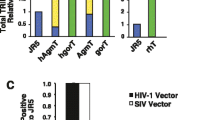Abstract
The host range of human immunodeficiency virus type 1 (HIV-1) is extremely narrow, which has hampered the establishment of non-human primate models for HIV-1 infection. The species-specific innate immune factor tripartite motif 5 alpha (TRIM5α) is a key molecule that confers potent resistance against HIV-1 infection. In this study, we targeted the TRIM5α gene of rhesus macaques (rhTRIM5α) using the transcription activator-like effector nuclease (TALEN) to study the effect on HIV-1 infection. CD4+ T cells were separated from the peripheral blood of rhesus macaques by magnetic cell sorting, and the positive rate was greater than 99%. TALEN plasmids targeting rhTRIM5α were constructed and introduced into CD4+ T cells by electroporation, with a transfection efficiency of approximately 25%. The genome of the targeted cells was extracted, and the target efficiency was analyzed by T7E1 enzyme digestion. After sorting the positive transductants, the TALENs induced rhTRIM5α mutations at a rate of more than 40%. The ability of the HIV-1 virus to infect the targeted cells was demonstrated by ELISA. The results showed that targeting rhTRIM5α enhanced the susceptibility to HIV-1 infection. This finding will pave the way for further establishment of a new rhesus macaque model for HIV-1 studies.





Similar content being viewed by others
References
Roberts RB, Murray HW, Rubin BY, Masur H (1984) Opportunistic infections and impaired cell-mediated immune responses in patients with the acquired immune deficiency syndrome. Trans Am Clin Climatol Assoc 95:40–51
Isanaka S, Mugusi F, Hawkins C, Spiegelman D, Okuma J, Aboud S, Guerino C, Fawzi WW (2012) Effect of high-dose vs standard-dose multivitamin supplementation at the initiation of HAART on HIV disease progression and mortality in Tanzania: a randomized controlled trial. JAMA 308:1535–1544
Bhatti AB, Usman M, Kandi V (2016) Current scenario of HIV/AIDS, treatment options, and major challenges with compliance to antiretroviral therapy. Cureus 8:e515
Hentrich M, Maretta L, Chow KU, Bogner JR, Schurmann D, Neuhoff P, Jager H, Reichelt D, Vogel M, Ruhnke M, Oette M, Weiss R, Rockstroh J, Arasteh K, Mitrou P (2006) Highly active antiretroviral therapy (HAART) improves survival in HIV-associated Hodgkin’s disease: results of a multicenter study. Ann Oncol 17:914–919
Stephenson KE, D’couto HT, Barouch DH (2016) New concepts in HIV-1 vaccine development. Curr Opin Immunol 41:39–46
Policicchio BB, Pandrea I, Apetrei C (2016) Animal models for HIV cure research. Front Immunol 7:12
Henning TR, Mcnicholl JM, Vishwanathan SA, Kersh EN (2015) Macaque models of enhanced susceptibility to HIV. Virol J 12:90
Jia X, Zhao Q, Xiong Y (2015) HIV suppression by host restriction factors and viral immune evasion. Curr Opin Struct Biol 31:106–114
Stremlau M, Owens CM, Perron MJ, Kiessling M, Autissier P, Sodroski J (2004) The cytoplasmic body component TRIM5alpha restricts HIV-1 infection in Old World monkeys. Nature 427:848–853
Sayah DM, Sokolskaja E, Berthoux L, Luban J (2004) Cyclophilin A retrotransposition into TRIM5 explains owl monkey resistance to HIV-1. Nature 430:569–573
Yap MW, Nisole S, Stoye JP (2005) A single amino acid change in the SPRY domain of human Trim5alpha leads to HIV-1 restriction. Curr Biol 15:73–78
Mussolino C, Alzubi J, Fine EJ, Morbitzer R, Cradick TJ, Lahaye T, Bao G, Cathomen T (2014) TALENs facilitate targeted genome editing in human cells with high specificity and low cytotoxicity. Nucleic Acids Res 42:6762–6773
Himathongkham S, Luciw PA (1996) Restriction of HIV-1 (subtype B) replication at the entry step in rhesus macaque cells. Virology 219:485–488
Nakayama EE, Shioda T (2015) Impact of TRIM5alpha in vivo. AIDS 29:1733–1743
Evans DT, Silvestri G (2013) Nonhuman primate models in AIDS research. Curr Opin HIV AIDS 8:255–261
Fennessey CM, Keele BF (2013) Using nonhuman primates to model HIV transmission. Curr Opin HIV AIDS 8:280–287
Friedrich BM, Dziuba N, Li G, Endsley MA, Murray JL, Ferguson MR (2011) Host factors mediating HIV-1 replication. Virus Res 161:101–114
Sauter D (2014) Counteraction of the multifunctional restriction factor tetherin. Front Microbiol 5:163
Pyndiah N, Telenti A, Rausell A (2015) Evolutionary genomics and HIV restriction factors. Curr Opin HIV AIDS 10:79–83
Li C, Guan X, Du T, Jin W, Wu B, Liu Y, Wang P, Hu B, Griffin GE, Shattock RJ, Hu Q (2015) Inhibition of HIV-1 infection of primary CD4+ T-cells by gene editing of CCR5 using adenovirus-delivered CRISPR/Cas9. J Gen Virol 96:2381–2393
Liu H, Chen Y, Niu Y, Zhang K, Kang Y, Ge W, Liu X, Zhao E, Wang C, Lin S, Jing B, Si C, Lin Q, Chen X, Lin H, Pu X, Wang Y, Qin B, Wang F, Wang H, Si W, Zhou J, Tan T, Li T, Ji S, Xue Z, Luo Y, Cheng L, Zhou Q, Li S, Sun YE, Ji W (2014) TALEN-mediated gene mutagenesis in rhesus and cynomolgus monkeys. Cell Stem Cell 14:323–328
Ding Y, Li H, Chen LL, Xie K (2016) Recent advances in genome editing using CRISPR/Cas9. Front Plant Sci 7:703
He Z, Proudfoot C, Whitelaw CB, Lillico SG (2016) Comparison of CRISPR/Cas9 and TALENs on editing an integrated EGFP gene in the genome of HEK293FT cells. Springerplus 5:814
Zhang Y, Huang H, Zhang B, Lin S (2016) TALEN- and CRISPR-enhanced DNA homologous recombination for gene editing in zebrafish. Methods Cell Biol 135:107–120
Acknowledgements
This study was supported by the Ministry of Science and Technology of China (2013ZX10001-004-002-005) and the Natural Science Foundation of Hubei Provincial Department of Education (Q20162110).
Author information
Authors and Affiliations
Corresponding authors
Ethics declarations
Competing interests
The authors declare that they have no competing interests.
Ethical standard statement and informed consent
None.
Rights and permissions
About this article
Cite this article
Wang, X., Yu, Q., Yuan, Y. et al. Targeting the rhesus macaque TRIM5α gene to enhance the susceptibility of CD4+ T cells to HIV-1 infection. Arch Virol 162, 793–798 (2017). https://doi.org/10.1007/s00705-016-3169-0
Received:
Accepted:
Published:
Issue Date:
DOI: https://doi.org/10.1007/s00705-016-3169-0




